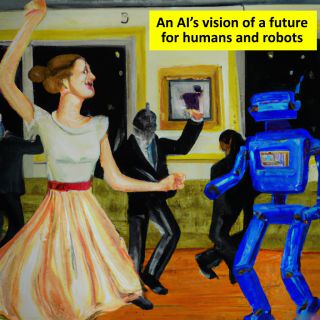Artificial Intelligence
How AI Will Change the World and Your Life, if You Let It
Generative, pre-trained innovation.
Posted February 11, 2023 Reviewed by Tyler Woods
Key points
- In the early 20th century, a similar technological innovation rocked the art world: photography. The response was Impressionism.
- Generative AI will launch an explosion of creative endeavor, which we could call Decentralism.
- Decentralist ideals will not only transform art and literature, but will pervade architecture, music, sex, marriage, urban planning.
- You can join the revolution by simply giving generative AI a try.

Everybody's talking about ChatGPT. My initial thought was that generative AI would likely be used to write dreck, like influencer blog posts and online marketing fodder for life coaches. In other words, the worthless textual flotsam of a society drowning in surveillance capitalism. So I figured that something like a haiku, which theoretically reflects deep wisdom, might help me determine whether generative AI has the chops to fake creativity effectively. The very first thing I did when I tried the ChatGPT beta was ask it to write a haiku about quantum computing (to make it easy for it), and it generated the following:
quantum bits spin
computing power unfolds
universe awed
I have to admit, this wasn’t bad. It even broke the 5-7-5 syllables rule, which I felt was a sign of poetic maturity. And so, I dove into the rabbit hole of large language models, along with every other tech leader out there.
Sensemaking and Meaningfinding
In the early 20th century, a similar technological innovation rocked the art world: photography. For centuries, art was based on mimesis, the literal imitation or representation of the appearance of nature, people, and society. In other words, art was supposed to be judged on the standard of how well it realistically reflected what something looked like. This made it easy to decide what “good” art was. Then the invention of photography came along, and people started asking, “Heck, why do we need artists at all, when a machine could reproduce images perfectly?”
Well, the first answer by artists was to invent impressionism, which expanded the meaning and purpose of art beyond mimesis. It was all about capturing the “impression” of reality by the human mind. Artists had to deconstruct what it meant to be an artist, in order to invent new artistic languages that could express the meaning of the changes that were happening in their world.
Now don’t forget, it wasn’t just photography. In the early 20th century things were changing so quickly that it was hard to keep up. An innovation firehose was aimed at civilization: electricity, the combustion engine, the incandescent light bulb, the automobile, the airplane, radio, X-rays, fertilizers, and so forth. It was hard to make sense of it all.
Artists, musicians, and writers sought to make sense of these changes, and in this process established a movement called Modernism. It was an artistic umbrella movement that included ground-breaking works by people like Schoenberg and Stravinsky in music; Klimt, Picasso, and Matisse in art; Le Corbusier and Rohe in architecture; and James Joyce, T. S. Eliot, and Virginia Woolf in literature. The movement came of age in the 1920s, with Bauhaus, Surrealism, Cubism, Fauvism, Futurism, and Dada. The essence of Modernism was to turn art into an act of rebellion that freed it from the past.
Photography didn’t put all artists out of work in the early 1900s, it ignited an explosion of new artistic thought and expression. And these new forms of art helped humanity to refine its thinking about what art really is, and what artists really are. The Modernist playwright and author Emile Zola said, “If you ask me what I came to do in this world, I, an artist, will answer you: I am here to live out loud.”

Creative artists and writers today are facing a similar transformation in what it means to be creative. Generative AI is just like photography, in that all you have to do is say, “Make me a painting, in the Cubist style, of a car that looks like an avocado” and bang, bob’s your uncle. And people have started asking, “Heck, why do we need artists at all, when an AI can create surrealistic or impressionistic paintings so easily?”
We need to see that humans make art like oysters make pearls. Pearls are formed when an irritant, such as a grain of sand, becomes trapped in the mollusk. To protect itself, the mollusk secretes substances that form its shell. It grows over time, forming the pearl. For an underpaid artist, generative AI can be an irritant. But it holds the potential to help those artists produce even more beautiful and meaningful art.
The Rise of Decentralism
Just as the Industrial Revolution powered the rise of Modernism, the Digital Revolution will power new movements in art. For lack of a better word, let’s call this next emergent art movement Decentralism. The factors that are likely to shape decentralism will be the relentless advancement of generative AI, the growth of cryptocurrency and NFTs, the formation of digital societies, climate change, pandemics, the rise of smart cities, and the rise of quantum computing.
Decentralist ideals will emerge that will not only transform art and literature, but will pervade architecture, music, philosophy, sex, marriage, urban planning, and everything we consider part of the human condition. This emergent artistic movement is likely to be based on decentralizing ideals of democracy, equality, and self-sovereign functionality, to offer a refreshing new take on the utopian vision of Modernism.
How to Join the Revolution
The new generative AI tools will, in the long run, unleash creativity for all of us. So how do you join this revolution? Where do you start? How do you start living life out loud?
Well, as a writer, I think that the strongest human urge seems to be to nitpick and edit someone else’s words… so consider using ChatGPT to come up with a bad first draft that could help you break through writer's block and get your creative juices flowing. ChatGPT is ideal because it’s “just an AI language model and I don’t have feelings”. Thank the stars it’s not sentient. (Yet.)
So do a test—take something you’ve written in the past, and use it to seed ChatGPT to come up with new ideas to improve it. Then nitpick the heck out of it. Does this process make your writing any better? Or, if you’re an artist, use a Generative AI art tool to come up with some concepts that prime the pump of your creativity. Once you get your feet wet, I think you’ll see that these are great new resources for artists and writers… they’re not going to put a million artists and writers out of work, as driverless trucks will for truck drivers. Or bots for customer service reps. Or whatever.
Where Are We Heading?
Now since this is a blog about innovation, I believe these tools will help humans learn how to innovate and ideate better, faster, and cheaper. First, you’ll find generative AI a useful tool for refining ideas, estimating startup costs, and outlining a business plan. You can ask it about business challenges and strategies. The job of an innovation coach is to help people think out of the box—I use a technique called “multivisioning.” I think ChatGPT could be modified to do exactly what I do in a brainstorming session, or a design sprint, which is usually about looking for blindspots and pain points.
Just as the pearl is intrinsic to the oyster, it isn’t just art that is intrinsic to our humanity. The ability to invent—whether it’s fire, the wheel, or the printing press… or AI, blockchains, and quantum computers—inventions are the pearls of humanity.
As we move further into the 21st century, tools like generative AI will prove to be instrumental in every aspect of life and will help to bring humanity to its greatest heights. Here's another haiku ChatGPT wrote...about this article:
pearls within oyster shells
generative AI and man
both a creation of art




